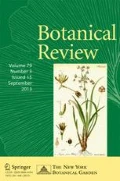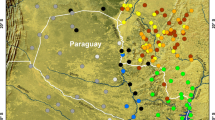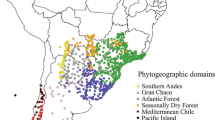Abstract
We present a statistically derived phytogeographic regionalization based on the spatial distribution of native woody flora, investigating environmental correlates and assessing congruence between the spatial patterns of species, genera, and families. A sector of central peninsular Italy (Lazio and Abruzzo regions) was selected as a case study. A rich georeferenced floristic database was compiled, including information from different sources. A total of 43,968 occurrence data, 290 10 × 10 km cells, 224 species, 103 genera, and 80 families was used; Ward’s clustering was performed to identify phytogeographic units. Three well-defined and relatively spatially coherent units were identified at the species, genus, and family levels: a Mediterranean unit, a Transition unit, and a Eurosiberian one. Congruence between taxonomic levels was well supported. Further divisions in subunits were detected using species data. The main environmental descriptors of the clusters were distance from the sea, elevation, temperature, and lithology.







Similar content being viewed by others
Literature Cited
Abbate, G., Bonacquisti, S., Burrascano, S., Giovi, E., Giuliani, A., Pretto, F., & Scassellati, E. 2015. Woody flora as a predictor of vascular plant richness: An insight in Italy. Plant Biosystems 149: 565–573.
———, Scassellati, E., Bonacquisti, S., Iberite, M., Latini, M., & Giuliani, A. 2016. Using woody genera for phytogeographic regionalization at a medium scale: A case study of Italy. Botany 94: 533–542.
Alves, C., Vieira, C., Almeida, R., & Hespanhol, H. 2016. Genera as surrogates of bryophyte species richness and composition. Ecological Indicators 63: 82–88.
Ampoorter, E., Selvi, F., Auge, H., Baeten, L., Berger, S., Carrari, E., Coppi, A., Fotelli, M., Radoglou, K., Setiawan, N. N., Vanhellemont, M., & Verheyen K. 2016. Driving mechanisms of overstorey–understorey diversity relationships in European forests. Perspectives in Plant Ecology, Evolution and Systematics 19: 21–29.
Bakker, J. D. 2008. Increasing the utility of indicator species analysis. Journal of Applied Ecology 45: 1829–1835.
Balmford, A., Jayasuriaya, A. H. M., & Green, M. J. B. 1996. Using higher-taxon richness as a surrogate for species richness: II. Local applications. Proceedings of the Royal Society B 263: 1571–1575.
Bartolucci, F., Peruzzi, L., Galasso, G. & Conti, F. 2016. Checklist aggiornata della flora vascolare autoctona d’Italia. Notiziario della Società Botanica Italiana 0: 5–6.
Bedini, G., Pierini, B., Roma-Marzio, F., Caparelli, K. F., Bonari, G., Dolci, D., Gestri, G., D'Antraccoli, M., & Peruzzi, L. 2016. Wikiplantbase #Toscana, breaking the dormancy of floristic data. Plant Biosystems 150: 601–610.
Bergamini, A., Scheidegger, C., Stofer, S., Carvalho, P., Davey, S., Dietrich, M., Dubs, F., Farkas, E., Groner, U., Kärkkäinen, K., Keller, C., Lökös, L., Lommi, S., Máguas, C., Mitchell, R., Pinho, P., Rico, V. J., Aragón, G., Truscott, A.-M., Wolseley, P., & Watt, A. 2005. Performance of Macrolichens and lichen genera as indicators of lichen species richness and composition. Conservation Biology 19: 1051–1062.
Blasi, C. (ed.). 2010. La Vegetazione d’Italia Con Carta delle Serie di Vegetazione in scala 1:500000. Palombi Editori, Roma.
———, & Michetti, L. 2007. Biodiversity and climate. In: C. Blasi, L. Boitani, S. La Posta, F. Manes, & M. Marchetti (eds.), Biodiversity in Italy. Contribution to the National Biodiversity Strategy (pp. 57–66). Palombi Editori, Roma.
———, Capotorti, G., Copiz, R., Guida, D., Mollo, B., Smiraglia, D., & Zavattero, L. 2014. Classification and mapping of the ecoregions of Italy. Plant Biosystems 148: 1255–1345.
———, Filibeck, G., Burrascano, S., Copiz, R., Di Pietro, R., Ercole, S., Lattanzi, E., Rosati, L., & Tilia, A. 2007. Primi risultati per una nuova regionalizzazione fitogeografica del territorio italiano. Biogeographia 28: 9–23.
Cailliez, F. 1983. The analytical solution of the additive constant problem. Psychometrika 48: 305–308.
Celesti-Grapow, L., Alessandrini, A., Arrigoni, P.V, Banfi, E., Bernardo, L., Bovio, M., Brundu, G., Cagiotti, M.R., Camarda, I., Carli, E., Conti, F., Fascetti, S., Galasso, G., Gubellini, L., La Valva, V., Lucchese, F., Marchiori, S., Mazzola, P., Peccenini, S., Poldini, L., Pretto, F., Prosser, F., Siniscalco, C., Villani, M.C., Viegi, L., Wilhalm, T., & Blasi, C. 2009. Inventory of the non-native flora of Italy. Plant Biosystems 143: 386–430.
Conti, F. 2004. Suddivisioni fitogeografiche della regione Abruzzo. Colloques Phytosociologique 28: 731–745.
———, Tinti, D., Bartolucci, F., Scassellati, E., Di Santo, D., Fanelli, C., Iocchi, M., Meister, J., Pavoni, P., & Torcoletti, S. 2010. Banca dati della flora vascolare d’Abruzzo: lo stato dell’arte. Annali di Botanica (Roma), Quaderni (suppl. 2009), 85–94.
De Cáceres, M., & Legendre, P. 2009. Associations between species and groups of sites: Indices and statistical inference. Retrieved September, 5, 2016 from http://sites.google.com/site/miqueldecaceres/
———, ———, & Moretti, M. 2010. Improving indicator species analysis by combining groups of sites. Oikos 119: 1674–1684.
Divíšek, J., Chytrý, M., Grulich, V., & Poláková, L. 2014. Landscape classification of the Czech Republic based on the distribution of natural habitats. Preslia 86: 209–231.
———, Storch, D., Zelený, D., & Culek, M. 2016. Towards the spatial coherence of biogeographical regionalizations at subcontinental and landscape scales. Journal of Biogeography 43: 2489–2501.
Dufrêne, M., & Legendre, P. 1997. Species assemblages and indicator species: The need for a flexible asymmetrical approach. Ecological Monographs 67: 345–366.
European Environmental Agency 2016. EEA reference grid, Italy shapefile. Retrieved September, 5, 2016 from http://www.eea.europa.eu/data-and-maps/data/eea-reference-grids-2.
Geoportale Nazionale 2016. Carta geolitologica d’Italia. URL: http://wms.pcn.minambiente.it/ogc?map=/ms_ogc/wfs/Carta_geolitologica.map. Retrieved September, 5, 2016 from http://www.pcn.minambiente.it/GN/accesso-ai-servizi/servizi-di-download/wfs.
Giacomini, V. 1958. Conosci l’Italia: La Flora. Touring Club Italiano, Milano.
Giorgini, D., Giordani, P., Casazza, G., Amici, V., Mariotti, M. G., & Chiarucci, A. 2015. Woody species diversity as predictor of vascular plant species diversity in forest ecosystems. Forest Ecology and Management 345: 50–55.
Heikinheimo, H., Eronen, J. T., Sennikov, A., Preston, C. D., Oikarinen, E., Uotila, P., Mannila, H., & Fortelius, M. 2012. Convergence in the distribution patterns of Europe’s plants and mammals is due to environmental forcing. Journal of Biogeography 39: 1633–1644.
Heino, J., & Soininen, J. 2007. Are higher taxa adequate surrogates for species-level assemblage patterns and species richness in stream organisms? Biological Conservation 137: 78–89.
Hijmans, R. J., Cameron, S. E., Parra, J. L., Jones, P. G., & Jarvis, A. 2005. Very high resolution interpolated climate surfaces for global land areas. International Journal of Climatology 25: 1965–1978.
ISPRA 2012. Corine land cover 2012 IV livello. Retrieved September, 5, 2016 from http://www.sinanet.isprambiente.it/it/sia-ispra/download-mais/corine-land-cover/corine-land-cover-2012-iv-livello/view.
——— 2016. DEM20. Retrieved September, 5, 2016 from http://www.sinanet.isprambiente.it/it/sia-ispra/download-mais/dem20/view.
ISTAT 2011. Annuario Statistico Italiano 2011 (p. 19). Istituto nazionale di statistica, Roma.
——— 2016a. Confini delle unità amministrative a fini statistici, Versione non generalizzata, WGS84 UTM 32N Anno 2016. Retrieved September, 5, 2016 from http://www.istat.it/it/archivio/124086.
——— 2016b. Popolazione residente al 1° gennaio. Retrieved September, 5, 2016 from http://dati.istat.it/Index.aspx?DataSetCode=DCIS_POPRES1.
Koleff, P., Gaston, K. J., & Lennon, J. J. 2003. Measuring beta diversity for presence-absence data. Journal of Animal Ecology 72: 367–382.
Kreft, H., & Jetz, W. 2010. A framework for delineating biogeographical regions based on species distributions. Journal of Biogeography 37: 2029–2053.
La Ferla, B., Taplin, J., Ockwell, D., & Lovett, J. C. 2002. Continental scale patterns of biodiversity: Can higher taxa accurately predict African plant distributions? Botanical Journal of the Linnean Society 138: 225–235.
Landeiro, V. L., Bini, L. M., Costa, F. R. C., Franklin, E., Nogueira, A., De Souza, J. L. P., Moraes, J., & Magnusson, W. E. 2012. How far can we go in simplifying biomonitoring assessments? An integrated analysis of taxonomic surrogacy, taxonomic sufficiency and numerical resolution in a megadiverse region. Ecological Indicators 23: 366–373.
Latini, M., Abbate, G., & Iberite, M. 2014. La flora legnosa del Lazio: allestimento di una banca dati geografica. In: L. Peruzzi, & G. Domina (eds.), Società Botanica Italiana, Gruppo per la Floristica, Sistematica ed Evoluzione “Floristica, Sistematica ed Evoluzione” (pp. 11–12). Tipolitografia Euroservice Punto Grafica, via Toselli Pietro Maggiore, 8 - Palermo.
Lavoie, C. 2013. Biological collections in an ever changing world: Herbaria as tools for biogeographical and environmental studies. Perspectives in Plant Ecology, Evolution and Systematics 2013: 68–76.
Legendre, P., & Legendre, L. 1998. Numerical ecology. Numerical ecology second English edition (2nd edn). Elsevier, Amsterdam.
Leprieur, F., & Oikonomou, A. 2014. The need for richness-independent measures of turnover when delineating biogeographical regions. Journal of Biogeography 41: 417–420.
Linder, H. P., de Klerk, H. M., Born, J., Burgess, N. D., Fjeldså, J., & Rahbek, C. 2012. The partitioning of Africa: Statistically defined biogeographical regions in sub-Saharan Africa. Journal of Biogeography 39: 1189–1205.
Lomolino, M.V, Riddle, B. R., Whittaker, R. J., & Brown, J. H. 2010. Biogeography (4th edn). Sinauer, Sunderland.
Magri, D., Agrillo, E., Di Rita, F., Furlanetto, G., Pini, R., Ravazzi, C., & Spada, F. 2015. Holocene dynamics of tree taxa populations in Italy. Review of Palaeobotany and Palynology 218: 267–284.
Mandelik, Y., Dayan, T., Chikatunov, V., & Kravchenko, V. 2007. Reliability of a higher-taxon approach to richness, rarity, and composition assessments at the local scale. Conservation Biology 21: 1506–1515.
Mantel, N. 1967. The detection of disease clustering and a generalized regression approach. Cancer Research 27: 209–220.
Márquez, A. L., Real, R., & Vargas, J. M. 2001. Methods for comparison of biotic regionalizations: The case of pteridophytes in the Iberian peninsula. Ecography 24: 659–670.
Mateo, R. G., Vanderpoorten, A., Muñoz, J., Laenen, B., & Désamoré, A. 2013. Modeling species distributions from heterogeneous data for the biogeographic regionalization of the European bryophyte Flora. PLoS ONE 8: e55648.
Oksanen, J., Blanchet, F. G., Friendly, M., Kindt, R., Legendre, P., McGlinn, D., Minchin, P. R., O'Hara, R. B., Simpson, G. L., Solymos, P., Stevens, M. H. H., Szoecs, E., & Wagner, H. 2016. Vegan: Community ecology package. R package version 2.4-1. Retrieved September, 5, 2016 from https://cran.r-project.org/package=vegan.
Olivero, J., Márquez, A. L., & Real, R. 2013. Integrating fuzzy logic and statistics to improve the reliable delimitation of biogeographic regions and transition zones. Systematic Biology 62: 1–21.
Peruzzi, L., & Bedini, G. 2015. Wikiplantbase #Toscana v2.1. Retrieved September, 5, 2016 from http://bot.biologia.unipi.it/wpb/toscana/index.html
Pignatti, S. 1982. Flora d’Italia. Edagricole, Bologna.
Plieninger, T., Höchtl, F., & Spek, T. 2006. Traditional land-use and nature conservation in European rural landscapes. Environmental Science and Policy 9: 317–321.
Prinzing, A., Klotz, S., Stadler, J., & Brandl, R. 2003. Woody plants in Kenya: Expanding the higher-taxon approach. Biological Conservation 110: 307–314.
QGIS Development Team 2014. QGIS geographic information system. Open source geospatial foundation project. Retrieved from http://www.qgis.org/
Qian, H. 2013. Environmental determinants of Woody Plant diversity at a regional scale in China. PLoS ONE 8: e75832.
R Core Team 2015. R: A language and environment for statistical computing. R Foundation for Statistical Computing, Vienna, Austria. Retrieved from https://www.r-project.org/
Ramette, A. 2007. Multivariate analyses in microbial ecology. FEMS Microbiology Ecology 62: 142–160.
Riddle, B. R., Ladle, R. J., Lourie, S. A., & Whittaker, R. J. 2011. Basic biogeography: Estimating biodiversity and mapping nature. In: R. J. Ladle, & R. J. Whittaker (eds.), Conservation biogeography (pp. 47–92). Wiley-Blackwell, Chichester.
Rivas-Martinez, S., Penas, A., & Diaz, T. E. 2004. Biogeographic maps of Europe. Retrieved July 8, 2016, from http://www.globalbioclimatics.org/form/bg_med.htm
Rueda, M., Rodríguez, M. Á., & Hawkins, B. A. 2010. Towards a biogeographic regionalization of the European biota. Journal of Biogeography 37: 2067–2076.
Scoppola, A., & Magrini, S. 2005. Bibliografia floristica per gli anni 1950–2005. In: A. Scoppola & C. Blasi (eds.), Stato delle conoscenze sulla flora Vascolare d’Italia (pp. 217–224). Palombi Editori, Roma.
Svenning, J. C., Normand, S., & Kageyama, M. 2008. Glacial refugia of temperate trees in Europe: Insights from species distribution modelling. Journal of Ecology 96: 1117–1127.
Takhtajan, A. L. 1986. Floristic regions of the world. University of California Press, Berkley.
Thiers, B. 2016. Index Herbariorum: A global directory of public herbaria and associated staff. New York botanical Garden’s virtual herbarium. Retrieved November 14, 2016, from http://sweetgum.nybg.org/science/ih/
Vilhena, D. A., & Antonelli, A. 2015. A network approach for identifying and delimiting biogeographical regions. Nature Communications 6: 1–9.
Villaseñor, J. L., Ibarra-Manríquez, G., Meave, J. A., & Ortíz, E. 2005. Higher taxa as surrogates of plant biodiversity in a megadiverse country. Conservation Biology 19: 232–238.
Ward, J. H. 1963. Hierarchical grouping to optimize an objective function. Journal of the American Statistical Association 58: 236–244.
Whittaker, R. J., Riddle, B. R., Hawkins, B. A., & Ladle, R. J. 2013. The geographical distribution of life and the problem of regionalization: 100 years after Alfred Russel Wallace. Journal of Biogeography 40: 2209–2214.
WorldClim 2016. WorldClim 1.4: Current conditions (~1960–1990), Bioclimatic variables, 30 arc-reconds resolution (~ 1km), Zone 16. Retrieved September, 5, 2016 from http://www.worldclim.org/tiles.php?Zone=16.
Author information
Authors and Affiliations
Corresponding author
Appendix
Appendix
Rights and permissions
About this article
Cite this article
Latini, M., Bartolucci, F., Conti, F. et al. Detecting Phytogeographic Units Based on Native Woody Flora: A Case Study in Central Peninsular Italy. Bot. Rev. 83, 253–281 (2017). https://doi.org/10.1007/s12229-017-9185-2
Published:
Issue Date:
DOI: https://doi.org/10.1007/s12229-017-9185-2




